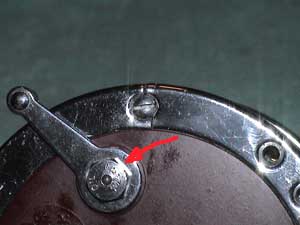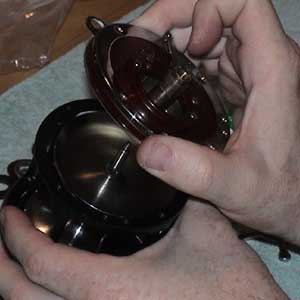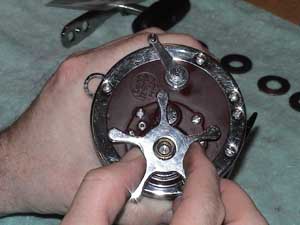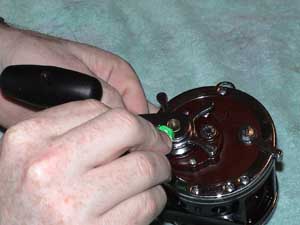|
|
PENN REEL MAINTENANCE |
|
by Ted Mackel |
I
chose to use a Penn Senator 113H for the reason that it is larger and easier to
see the pictures. The Penn 500
Jigmaster, 200 (Surfmaster), 140 (Squidder) and 100 (Surfmaster narrow) are very
close with only very minor differences. For the smaller reels, I prefer the older Surfmaster series
200 and 100s over the Squidder series because for kayak fishing the 200 and 100
do not have a bearing. The bearing-less feature makes the reel much more
tolerant to sand. While sand is to
be avoided at all costs, sometimes kayak fisherman get lazy in the surf zone or
just have a mishap. Yes, for more money you can get a better reel, but
dollar for dollar vs. life expectancy, these Penn reels can take abuse and you
can keep them going very inexpensively. Parts are inexpensive and easy to
replace on your own.
I
am no expert at reel maintenance, but by the time you read through the
instructions, you will see how easy it is to maintain these reels on your own.
One exception is that you need some mechanical ability and a set of
tools. If you do not already own
the tools shown in this article, then it might be a good idea not to attempt
this project.
The
reassembly of the right side, works on pretty much any Penn "star
drag" reel . This Penn Senator 4/0 (113H) was manufactured in the 1970s.
The white handle is a good indicator as to itís age, but not always a
reliable indicator. This reel needs basic work over and above a good cleaning.
The right side plate outer ring is cracked.
The knob on the handle is frozen, there is some corrosion on the chrome
parts and I will be replacing/upgrading from a 3 drag washer system to a 5 drag
washer system. I will also be installing a new Accuframe.
You will need the following items:
|
First start by arranging your work area. I use my kitchen table and spread out a large towel for my work area. As you take apart the reel try and layout the parts in groups as they come off the reel.
Start
by removing the outside screws on the right side plate. Once you have the right
side plate off, pull out the spool.
|
|
|
|
Turn
the reel around and remove the screws on the left side plate. You will
need to hold the frame rods as they will spin as you turn the screw
driver. The five frame rods on an older reel will probably show the most corrosion.
If you are not installing an Accuframe as I am in this project, use steel wool
to
Once the left side plate is off, pop off the outer rings and spray WD40 on everything. Take an old tooth brush and scrub all the parts. Make sure to clean the clicker parts (see red and blue arrows in picture below) and the left side bearing. Use the steel wool on the outer rings and harness lug if needed. Do not leave the harness lug out even if you don't use it. This open area will let in saltwater and sand if you do not put it back. Remember, you can use the harness lug with leashes on your kayak. Wipe everything clean and place grease on the clicker parts and Penn Lube in the spool spindle hole (see the red and blue arrows in the picture below).
WARNING ON WD40 - WD40 is a
great cleaner and temporary lubricant. It will evaporate and dry out very
quickly. It's solvent properties make it great for cleaning, but please
wipe down all your parts before using lubes and grease on reassembly. Do not use
it in place of the other lubricants mentioned in this project.
|
|
|
|
|
If you are lucky, the drag washers will not be gummed up and stuck inside. You can see on this reel, that you can change these washers without taking the reel apart. This is helpful on a long trip, if you burn out your drags. The problem with this feature is that you can get lazy and forget about the fiber washer on the inside. The fiber washer needs to be changed each time you change your drags as the fiber washer is part of the drag system. You can see in the picture below on the right (circled in red) that I removed only four washers. Two of the metal washers were stuck to the washers, to the point I had to take a razor knife to separate them. These are the original thick washers that came in the 3 drag system. These will not be reused in the 5 drag washer upgrade.
|
|
|
Next take out the screws that hold on the bridge assembly (see picture above on right side). Hold your hand across the back on the plate when you remove the bridge screws so you can flip it over and look at the eccentric and pinion assemblies as you pull out the bridge assembly.
The red arrow in the picture below on the left shows the old fiber washer still on the bridge assembly. The green arrow in the same picture shows the dog pin and the blue arrow in the same picture shows the dog spring. Take the old fiber washer off the bridge assembly and clean the bridge assembly with WD 40, an old tooth brush and steel wool if needed After it is clean place the new fiber washer on the bridge assembly. Carefully take out the dog pin and dog spring and set aside (see the blue and green arrows, below left). The spring can disappear easily so be careful.
Next take needle nose pliers and disengage the eccentric spring (see blue arrow in picture below on left). In the picture below, I had already taken the eccentric lever out and forgot to take a picture first, otherwise it should still look like the picture in the upper left without the dog pin and dog spring. The outer rings will not come off the side plate without removing the eccentric lever. Flip the plate over and remove the eccentric nut and take off the lever. You can now remove the outer rings. Flip over the plate and you will be able to remove the eccentric, eccentric spring, eccentric jack, pinion yoke, pinion, two clutch springs, main gear, bearing and wave washer. Clean all parts with WD40 and tooth brush thoroughly. Clean the outer rings, lug and side plate. The outside ring on this right plate is cracked. I picked up a replacement ring from my local tackle shop for $1.00 used. You can see the crack in the picture below, center.
 |
If you cannot put the drags in from the outside like on this older reel, you will need to put the drags in now (scroll down to the drag installation procedure). If you flip over the main gear, this is where you insert the drag washers. Then put the gear in the side plate.
Next, place the springs in (shown by the red arrows in picture below left). Take the pinion and pinion yoke and put together (See below center picture). Next take the eccentric jack and place over the pinion and pinion yoke.
Now place the main gear in. Take one of the bridge screws (see red arrow in picture below left) that is threaded all the way and insert it in the hole that corresponds with the dog pin (see red arrow in picture below right) . Take the dog spring and install (see red arrow in picture below left). Next take the bridge and slide it through the main gear down on to the side plate (Picture below right).
Take a thin screw driver and slide it between the bridge and main gear to set the dog pin, it sets into the ratchet (which is the toothed cog at the bottom of the bridge assembly) and so the bridge will seat properly. While holding the bridge in place tightly, flip over the plate and screw in the bridge screws. Once all four screws are in place, flip over the side plate and lube the main gear with Penn lube and place the chrome ring on the inside of the plate.
I am not a fan of grease on the parts in the right side for several reasons. Grease is like fly paper, any dirt that gets in there, gets stuck. On the side of the reel there are several places to inject Penn Lube oil and if you have the entire right side packed with grease, you will never be able to get Penn Lube oil in. Last, drag washers should only be coated with drag grease. Regular grease will become gummy and can be corrosive to the drag material. This will all make your drag stick and not smooth.
Next, taking an Accuframe in place of the frame bars and frame base plate, screw the side plates on. Make sure not to forget to install the harness lugs. The reason for the Accuframe upgrade is that the frame stabilizes the side plates and aligns them much better than the frame bars. This addition will not only make the reel operate much more smoothly, but also increase casting efficiency.
 |
Now it's time to install the drags. In the red circle you can see the old three drag washer system. The new 5 drag washer system is numbered in the order it will be installed. You will notice that the eared washers are in position 4 and 8. Thinly coat each of the non-metal drag washers with drag washer grease. Do not use regular grease. Go to your tackle shop and ask for drag washer grease.
|
|
Next, install the washer set as follows.
Non metal washer, metal washer, non metal washer, metal eared washer, non metal
washer, metal washer, non metal washer, metal eared washer, non metal washer,
metal washer, tension spring, spacing
sleeve, tension spring.
 |
 |
 |
Next, install the star wheel and put some Penn lube in the center of the main gear shaft. Then install the new handle, handle nut and handle locking screw and you should be ready to go to the tackle store and load up new line.
 |
 |
|
|